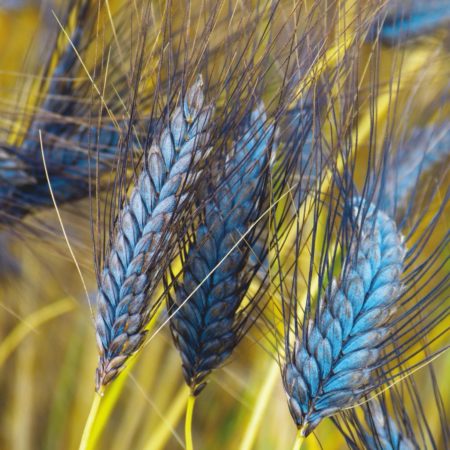- Molecular markers as a tool for germplasm acquisition to enhance the genetic diversity of a Napier grass (Cenchrus purpureus syn. Pennisetum purpureum) collection. Win-win for the ILRI and Embrapa genebanks.
- Women’s empowerment in agriculture and agricultural productivity: Evidence from rural maize farmer households in western Kenya. 1% increase in women’s empowerment led to a 6-16% increase in maize yields, depending on fanciness of math.
- A transcriptome screen for positive selection in domesticated breadfruit and its wild relatives (Artocarpus spp.). Evidence of selection in 1000 genes.
- A selfish genetic element confers non-Mendelian inheritance in rice. Pollen toxin-antidote genetic system controls hybrid sterility in wild-cultivated crosses.
- Between China and South Asia: A Middle Asian corridor of crop dispersal and agricultural innovation in the Bronze Age. It’s not all demic diffusion.
- Determinants of crop diversification in rice-dominated Sri Lankan agricultural systems. Not everyone can diversify.
- Improving food-system efficiency and environmental conservation using agricultural biodiversity in Busia County: a pilot study. Giving farmers nutritional data increased their cultivation of traditional vegetables, and their income.
- The impacts of farmers’ livelihood endowments on their participation in eco-compensation policies: Globally important agricultural heritage systems case studies from China. Giving farmers money increased their income.
- Conservation of wild silkworm genetic resources through cryopreservation: Standardization of sperm processing. It’s best to recover sperm from the bursa copulatrix and spermatheca of the female moth after mating.
- Short-Term Local Adaptation of Historical Common Bean (Phaseolus vulgaris L.) Varieties and Implications for In Situ Management of Bean Diversity. 3 years of multiplication of heritage varieties in contrasting organic farms leads to genetic changes: it takes a network to truly conserve.
Brainfood: Potato errors, Cryo maize, Fish ABS, Salamander poaching, Better niches, Diverse urban farms, Old growth, Space seeds, Breeding networks, Mating systems
- Genetic Identity in Genebanks: Application of the SolCAP 12K SNP Array in Fingerprinting and Diversity Analysis in the Global In Trust Potato Collection. 11 mismatches between 250 original samples and their putative in vitro counterparts.
- Maize seed cryo-storage modifies chlorophyll, carotenoid, protein, aldehyde and phenolics levels during early stages of germination. But do the effects last?
- Sharing aquatic genetic resources across jurisdictions: playing ‘chicken’ in the sea. Fish resources need cooperative governance too.
- Imminent extinction in the wild of the world’s largest amphibian. Because it’s a luxury food, believe it or not.
- Community structure informs species geographic distributions. Include coexisting species in niche models for better results.
- Increasing plant diversity with border crops reduces insecticide use and increases crop yield in urban agriculture. Planting soybeans, maize and vegetables around rice was bad for pests and good for profits in Shanghai.
- Where are Europe’s last primary forests? Mountains, mainly.
- Seeds in space. Orbiting Svalbard, anyone?
- Resistance Genes in Global Crop Breeding Networks. Networks for cassava, potato, rice, and wheat “are clustered due to phytosanitary and intellectual property regulations, and linked through CGIAR hubs.”
- Plant Mating Systems Often Vary Widely Among Populations. One estimate is never enough.
Talking, and tweeting, cassava in Benin
If you’re at all into cassava, you’re probably at the IVth International Cassava Conference. If you can’t make it, you can of course follow on Twitter, and probably lots of other ways too. James Legg is, as usual, particularly active.
Buzz in the house changes to a hush as the Global Cassava Partnership for the 21st century 2018 (GCP21) gets underway at the Marina Hotel, Cotonou. An exciting programme on Global cassava research ahead for the coming week @IITA_CGIAR @benin #GCP21benin2018 pic.twitter.com/8f4ionpONc
— James Legg (@jamesplegg) June 11, 2018
And here’s a nice idea, a prize for the best cassava pic.
https://twitter.com/aszyniszewska/status/1006786458139709440
LATER: Finally, James again, bringing it all together.
Global Cassava Partnership for the 21st century – Benin 2018
Wheat landraces get together
As part of the 1st International Conference of Wheat Landraces for Healthy Food Systems, the local host is planning a field day that would showcase a variety of wheat landraces, including those sent in by conference participants.
Another nice idea.
Hen Gymro "old Welsh" landrace wheat on a trip to Italy for #ICWL18 #IWLC18 #landraces #anciengrains https://t.co/rdpRffavN9 for @Brockwell_Bake & @WelshGrain , Andrew @scotlandbread & Eyal @e5bakehouse checking how it has travelled, looking good. pic.twitter.com/kFEniNFqIr
— Brockwell Bake (@Brockwell_Bake) June 15, 2018
Where is Utrecht blue wheat from?

We have this beautiful wheat in our collection, received from Sharon Rempel. However, we cannot trace it coming from the NLD. Utrecht area was not a wheatgrowing area. In the early 1900s durum and emmer was not grown in NLD. If any one knows its origin, please let us know!
— Centre for Genetic Resources, the Netherlands (@CGN_Wageningen) June 12, 2018
Can you help our friends at CGN? There is a wheat of this name in Genesys whose origin is given as Canada, but I can find no Utrecht in that country.